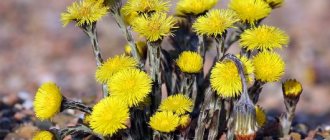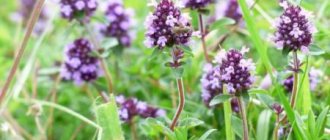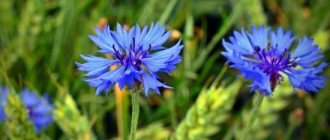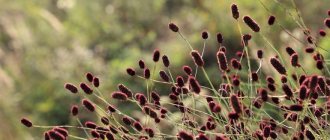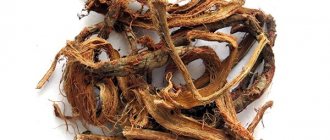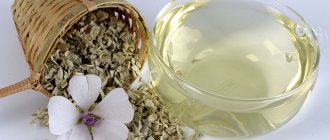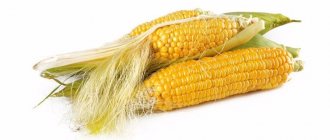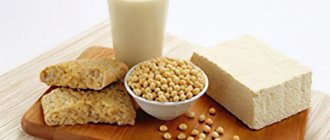Strong bushes of common yarrow with pubescent leaves and an umbrella of cream flowers grow on the edges of forests, along roadsides and among meadow vegetation.
This popular plant is effective in the treatment and prevention of a wide range of diseases, improves digestion, stops bleeding and enhances metabolism.
The article discusses the properties of yarrow, as well as the best recipes and features of the use of medicines based on it.
Historical facts
In folk medicine, the plant is highly valued and has been used for centuries.
The history of medicinal use of yarrow originates in the myths of Ancient Greece. Ancient chronicles mention a story that the grandson of Dmitry Donskoy, who suffered from severe nosebleeds, was cured with yarrow.
The plant has been known since ancient times. Dioscorides called it Herba vulnenaria, that is, a wound herb that was used for bleeding and to treat wounds. According to Pliny, yarrow got its name in honor of Achilles, who healed Telephus’s unhealed wound with it.
Other sources claim the origin of the name from the Greek achillos - abundant food or from achillon - thousand.
Appearance
Photo: Pixabay
Yarrow is difficult to confuse with other plants. This is a Eurasian species that has been introduced to other continents. It is found almost throughout the entire territory of Russia, with the exception of the northernmost regions.
The plant is a perennial and can reach a height of 20 to 80 centimeters. It has a long, cord-like creeping rhizome.
The leaves are pinnate, pubescent with a large number of small thin cilia, which give the plant its name. The stem at the top bears an inflorescence - a shield with small flower baskets. Each basket consists of 5-7 marginal flowers with white or pink tongues and several central tubular ones.
This inconspicuous plant is considered a good honey plant. It blooms for a long time, flowering begins in June and ends in late autumn in September - October.
Medicinal properties of yarrow
For medicinal purposes, traditional and official medicine uses the above-ground part of a flowering plant, that is, grass. The herb contains up to one percent essential oil, alkaloids, vitamin K, ascorbic acid, and organic acids. Beneficial carotene, bitter and tannin substances were also discovered.
The plant is valued primarily for its hemostatic properties. These amazing properties of the herb were known to the people a long time ago; for this reason, yarrow is popularly called bloodworm. The plant is one of the most popular traditional medicines. Dysentery and other gastrointestinal diseases were treated with herbal infusions.
✔ Scientific research has proven that the alkaloid achillein contained in yarrow increases blood clotting. Medicines based on the plant have amazing properties: they never lead to the formation of blood clots.
✔ The importance of yarrow in folk medicine is great. Its drugs have anti-inflammatory, bactericidal and antiallergic properties.
✔ Medicines based on yarrow enhance the contraction of the uterine muscles. This amazing healing property of the plant allows it to be used to treat heavy menstruation, fibroids and inflammatory diseases of the uterus.
✔ Yarrow is famous for its wound-healing, choleretic and diaphoretic effects. Medicines based on it can relax the smooth muscles of the intestines and urinary tract.
✔ Plant preparations help lower blood pressure, increase bile secretion, and also stimulate milk production in nursing women.
For what diseases is the herb used?
Yarrow is used as an effective remedy in the form of various dosage forms in the following cases.
External use in folk medicine
- In the treatment of skin injuries, to stop bleeding in fresh wounds, treatment of ulcers, including purulent ones, as well as boils.
- As a cosmetic product, yarrow perfectly smoothes the skin, reduces the formation of wrinkles, removes oily shine, shrinks pores, and has a slight whitening effect.
To make your facial skin look rested and matte, wash your face with an infusion of yarrow leaves with the addition of chamomile flowers in equal parts at the rate of half a tablespoon of raw material per half liter of water.
- Yarrow is widely used in folk medicine as a remedy for strengthening hair and giving it shine, for baldness, and also for the prevention of oily seborrhea of the scalp.
- For eczema and dermatitis - externally in the form of compresses.
While working in your summer cottage or relaxing on a picnic, you can accidentally cut yourself. To stop the bleeding and at the same time avoid suppuration of the wound in the field, apply a yarrow leaf rubbed between your fingers to the damaged area.
Oral use
Medicines based on yarrow are effective for diseases of the following organs and systems:
- Cardiovascular system: for tachycardia, bleeding, and also for blood purification.
- For pathologies of the respiratory system: pulmonary hemorrhages, chronic and acute bronchitis, tuberculosis.
- To eliminate dysfunctions of the gastrointestinal tract: flatulence, gastritis, to reduce stomach cramps, hemorrhoids.
- As an excellent remedy for the treatment of cystitis, chronic and acute inflammation of the kidneys.
- In gynecology for uterine bleeding and menstrual irregularities.
Uses of yarrow
In folk medicine, fresh plant juice, decoctions of flowers and leaves, as well as ointments based on medicinal raw materials are used.
An infusion of the plant acts as a blood pressure lowering agent; it slows down heart contractions. The bitter herb of the plant stimulates the secretion of the salivary glands, enhances the secretion of gastric juice and bile secretion. Taking the infusion internally helps reduce flatulence.
✔ In folk medicine, yarrow infusion is used for uterine, pulmonary and hemorrhoidal bleeding.
✔ The steamed herb of the plant can be used as a local anesthetic for soft tissue bruises. For life-saving lotions, you can use not only fresh grass, but also pharmacy preparations.
✔ Yarrow has also found its place in cosmetic skin care. Its decoction is used for washing and lotions on pustules and boils.
✔ Traditional medicine offers the ready-made drug Rotokan. It is a mixture of chamomile, marigold and yarrow extracts. Rotocan is used in official medicine for inflammatory diseases of the oral mucosa.
Yarrow. Beneficial features
Among the properties of yarrow:
- Antibacterial and anti-inflammatory. The ability to disinfect wounds explains the popularity of yarrow as a medicinal product, especially in folk medicine. It is thanks to its bactericidal properties that, according to the regulations, every soldier of Suvorov’s army had to have dry powder from yarrow in his personal first aid kit. These qualities of yarrow have not been forgotten today. In the form of decoctions and infusions, yarrow is used to relieve inflammatory processes.
- Hemostatic. Yarrow can stop external and internal bleeding, in particular it is used to stop nosebleeds, dental bleeding, and is used for wounds, abrasions and scratches, as well as pulmonary and uterine bleeding. Yarrow decoction is often used for severe bleeding after childbirth. Undoubtedly, you cannot stop arterial bleeding from a large vein with yarrow, but as for vascular or capillary bleeding, small wounds and abrasions, yarrow copes “excellently” here, without causing blood clots.
- Calming and strengthening. Thanks to these properties, yarrow can be used in the treatment of colds and flu. Having a beneficial effect on various systems of the body, yarrow promotes a speedy recovery, strengthening the body's strength. Among the properties of yarrow is diaphoretic, which helps cope with high temperatures during fever.
Yarrow in folk medicine
Photo: Pixabay
In folk medicine, the plant is used for internal and external use. To treat purulent wounds, both fresh plant juice and an ointment prepared on its basis are used.
It doesn’t matter if you can’t prepare your own herbs for treatment during the long winter. Dry yarrow herb is sold in any pharmacy, depending on the weight, its cost ranges from 30 to 100 rubles.
Infusion for washing
Take 50 grams of dry yarrow and chamomile herbs. Pour three liters of boiling water. Let sit until cool. Use morning and evening to wash your face.
Ointment for treating wounds
The only disadvantage of this product is that it can only be made from fresh raw materials, that is, in the summer. Take a handful of yarrow inflorescences and leaves and pound in a mortar until you get a homogeneous mass. Mix the resulting mass 1/1 with rendered unsalted lard. Do not store the ointment and use freshly made ointment to treat wounds. This ointment is an excellent remedy for healing a newly made tattoo.
Plant juice
Collect fresh yarrow inflorescences and leaves, wash, clear of debris and mince. Squeeze out the mixture and mix the resulting juice with honey in a ratio of 1/1. Take one tablespoon of juice 2 times a day to improve digestion, for liver diseases, gall bladder and improve appetite.
For the treatment of bronchitis
✔ Plant tincture. Collect fresh herbs from the plant, pour 30 grams of herbs into 200 ml of vodka. Let it brew in a dark, cool place for a week. Then strain it and squeeze out the raw materials. Store the tincture in the refrigerator; for acute bronchitis, take 40–50 drops of tincture 4 times a day.
✔ Yarrow decoction for the treatment of bronchitis. Pour twenty grams of dry herb with a glass of boiling water, put on low heat and simmer for 15 minutes. Cool, strain and take 1-2 tablespoons before meals.
Nosebleeds
Pour one teaspoon of herb with a glass of boiling water. Leave for half an hour, strain and drink two glasses a day. Fresh herbal juice stops bleeding. You can mash the fresh leaves of the plant, squeeze out the juice and drop it into your nose.
Heartburn
Pour one teaspoon of herb with 200 ml of boiling water. Let sit for five minutes. Strain and drink 400 ml of infusion daily.
Sciatica and lower back pain
Pour 200 ml of boiling water over one tablespoon of dry herb, cover with a lid and let steep for an hour. Strain and take one tablespoon 3-4 times a day before meals.
Uterine bleeding
Prepare an infusion: pour one tablespoon of herb with inflorescences into 300 ml of boiling water. Let it brew for one hour in a warm place, strain. Take 1/3 cup 3 times a day after meals.
Yarrow infusion
A warm infusion of the plant can be used as a mouth rinse for stomatitis and gum inflammation. The infusion is effective in combating bad breath. Preparing the infusion is simple: pour two tablespoons of herbs into 1/2 liter of boiling water and leave for an hour.
Application in cosmetology
Yarrow is widely used for cosmetic purposes. It perfectly tones the skin and helps tighten pores. It is often used:
- for acne;
- for oily facial skin;
- with peeling of the skin;
- to get rid of dandruff;
- as an anti-wrinkle agent.
For face
For narrowing blood vessels and pores on the face, as well as for eliminating various inflammatory formations, masks made from pink yarrow flowers have proven themselves well. To prepare the cosmetic mixture you need:
- one tablespoon of dry pink inflorescences;
- half a glass of boiling water;
- one teaspoon of starch;
- a large spoon of low-fat sour cream.
All components are mixed and carefully applied to the skin of the face. After fifteen minutes, the mask is washed off with water.
For hair
The perennial herb also has a beneficial effect on the scalp. Masks and rinses are prepared from the plant, which make hair elastic, healthy and silky.
The following mixture helps against hair loss:
- three spoons of grass;
- a small spoon of dry mustard;
- a tablespoon of olive oil.
To begin with, prepare a decoction of yarrow from herbs and water. Then mustard and oil are added. The mixture is applied to the head for forty minutes. After expiration, the mask is washed off. Before use, you should check your scalp for scratches or cuts, as the healing solution may cause burning and pain in such areas.
Yarrow essential oil is often prepared for cosmetic purposes. It can be obtained by steam distilling the inflorescences of the plant. It is applied to the hair, combined with egg yolk, honey or simply with shampoo. This oil is used against hair loss, to get rid of dandruff and to restore the scalp. This oily product is sold in pharmacies as a therapeutic and prophylactic drug with anti-inflammatory and antiseptic characteristics.
Contraindications
Photo: Pixabay
As such, there are no contraindications to taking plant-based medications. However, internal use of the plant requires caution.
With prolonged use and taking large doses of yarrow preparations, unpleasant consequences are possible. Nausea, dizziness and skin rashes may occur.
Contraindications for using yarrow preparations
A medicinal plant used without knowledge of its characteristics can do more harm than good. Let's consider cases of contraindications for taking yarrow-based drugs.
Hypotension
As a remedy that gently lowers blood pressure and slows the heart rate, yarrow should be taken with caution in case of hypotension. However, in small doses or externally, taking the drug is quite acceptable.
Allergic reactions
Herbal medicines contain potent biologically active substances, so you need to check their effect on the body from the point of view of possible allergic reactions.
Advice. For external use, apply the composition to a small area of healthy, clean skin for 15 minutes. If redness, itching or burning occurs, rinse immediately with water and do not use the product in the future.
If you are allergic to any plants, it is necessary to check in the laboratory for the presence of an allergic reaction specifically to yarrow and take the medicine orally only after that.
Gastritis with high acidity
The bitterness and alkaloids of yarrow stimulate the production of gastric juice, so you should not take plant preparations.
Pregnancy and gynecology
Yarrow remedies cause contraction of the muscles of the uterus, which can lead to complications during pregnancy.
There is a misconception that yarrow preparations cause blood clots. In fact, the mechanism of action of the active substances of this plant during blood clotting is similar to the action of calcium ions and therefore cannot provoke thrombosis.
In any case, you should not exceed the dosage of medications and use them for a very long time, since many substances can accumulate and, if abused, cause intoxication of the body.
Procurement of raw materials
There is no shortage of raw materials for this medicinal plant, but you can stock up on the herb for future use. The grass lends itself well to harvesting. But there are still little tricks.
It is advisable to cut shoots in the middle of their height or just the tips of the shoots during flowering. The lower part of the plant is very rough, and its healing qualities are low.
Do not try to pluck shoots with your hands or break them off. This is unlikely to be possible: the stems of the plant are so strong that it is more likely to pull the plant out by the roots than to tear off the upper part of the shoot.
You can’t get high-quality raw materials without a knife. Cut shoots should be tied into bunches and hung to dry in the attic, barn, or under a canopy. The grass should only be dried in the shade; in good weather it dries in ten days. Readiness can be checked by the degree of fragility of the stems
The shelf life of dry raw materials in a closed glass container is no more than two years. But healers advise not to store raw materials for a long time, but to prepare them annually.

